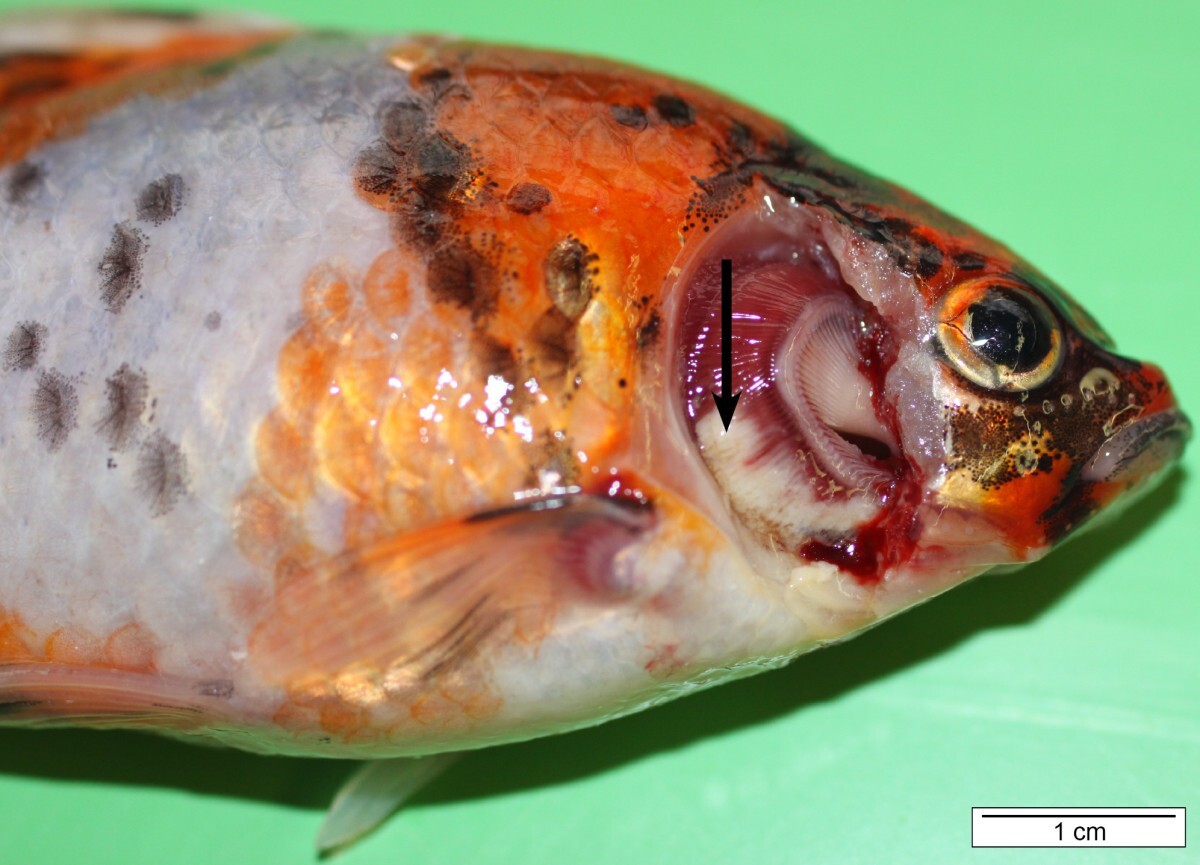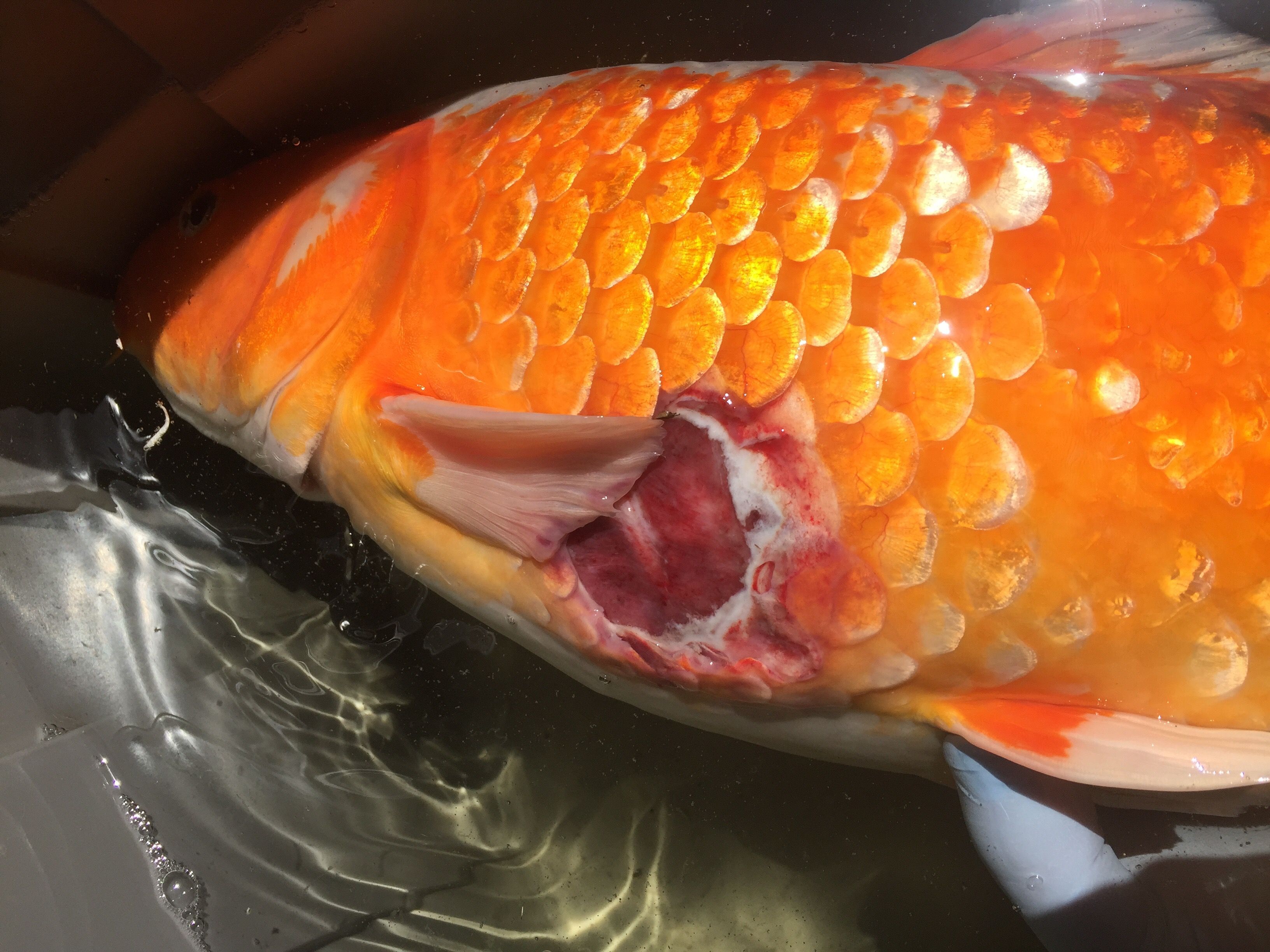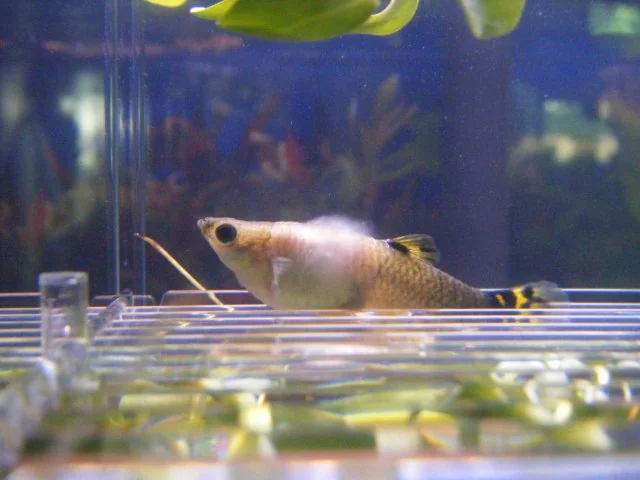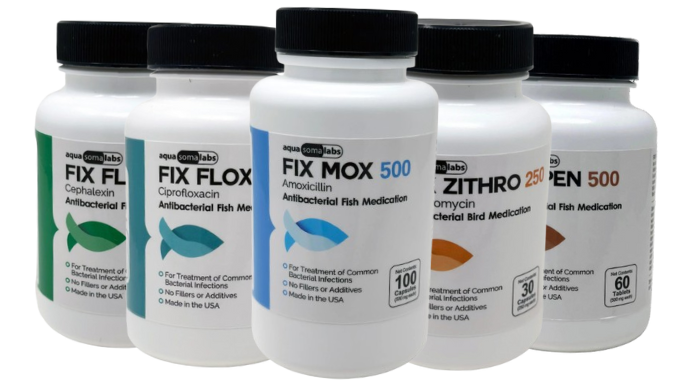Posted by Aquatic Veterinary Specialist on 23rd Apr 2025
Columnaris Disease in Aquarium Fish: Causes, Symptoms & Treatment
Columnaris Disease in Aquarium Fish

Columnaris disease – also known as cotton wool disease, cotton mouth disease, or saddleback disease – is a common and highly contagious bacterial infection in freshwater aquarium fish. It is caused by the bacterium Flavobacterium columnare, which thrives in warm, poorly maintained aquariums. Columnaris often appears as white, fluffy or mold-like patches on fish (hence the nickname “cotton mouth” or “fish mouth fungus”) and can be mistaken for a fungal infection due to its fuzzy appearance. This disease is a serious concern for aquarium hobbyists because it spreads rapidly and can wipe out entire fish populations within hours if left untreated. In this article, we’ll explain what Columnaris is, its causes, symptoms and stages of progression, how to treat it (including a fish treatment guide for Columnaris disease), and ways to prevent future outbreaks.
What is Columnaris Disease?
Columnaris is a bacterial disease in fish resulting from infection by Flavobacterium columnare. The bacteria are Gram-negative, rod-shaped, and present in most aquatic environments. Healthy fish can carry the bacteria without issue, but if fish become stressed or injured, the pathogen can opportunistically invade and cause infection. Because Columnaris bacteria often clump together in fluffy colonies, the disease’s lesions look cottony or moldy, leading to descriptive names like cotton wool disease, cotton mouth, or saddleback (for the patches on a fish’s back).
Columnaris can infect many freshwater species (tropical community fish, livebearers, goldfish, catfish, bettas, etc.). Infected fish may suffer external infections on skin, fins, gills, or mouth, and less commonly internal infections in organs. The disease can manifest in two forms:
-
Chronic Columnaris: A slower-progressing form where symptoms develop over several days. Fish may survive longer with treatment, but without intervention the infection steadily worsens.
-
Acute Columnaris: A fast-progressing form (often at higher temperatures or in very young fish) that can kill fish within 24 hours. In acute cases, fish might show few external signs aside from rapid breathing or flashing before sudden death. Quick action is critical when an acute outbreak is suspected.
Causes of Columnaris Outbreaks

Columnaris outbreaks are usually triggered by stressful conditions or poor tank maintenance, which weaken a fish’s immune system and allow the ubiquitous bacteria to infect. Common causes and risk factors include:
-
Poor water quality: Elevated ammonia or nitrite, high nitrate, or low oxygen levels put stress on fish and foster bacterial growth. Dirty tanks with lots of organic waste (uneaten food, detritus) create a breeding ground for Columnaris bacteria.
-
High water temperature: Flavobacterium columnare thrives in warm water and multiplies faster at higher temperatures. Temperatures above ~75–80°F (24–27°C) can accelerate the disease. (Many tropical fish live in this range, so outbreaks often happen in heated tanks.)
-
Stress and crowding: Overcrowded tanks or aggressive tank mates lead to chronic stress for fish. Stress suppresses immunity, making fish more susceptible to columnaris infection. Shipping or handling stress (e.g. new fish arrivals) can also trigger outbreaks.
-
Injuries or tissue damage: Any break in a fish’s slime coat or skin (such as fins nipped by other fish or damage during netting) provides an entry point for the bacteria. Columnaris often invades through gill tissues, mouth, or skin wounds.
-
Poor diet or malnutrition: Fish on an inadequate diet may have weakened immune defenses, making them easier targets for infection.
-
Introduction of infected fish: New fish carrying F. columnare can introduce the bacteria to a tank. Without quarantine, a carrier fish (even if it looks healthy) might spread Columnaris to others, especially if the new environment stresses the fish.
Once present, Columnaris is highly contagious. It spreads through the water column and can be transmitted via shared equipment (nets, siphons, containers) or even contaminated food. All it takes is one infected fish or cross-contamination between tanks to start an outbreak. Aquarium keepers should practice good hygiene and sterilize equipment between tanks to avoid spreading the bacteria.
Symptoms and Stages of Columnaris (Cotton Mouth Disease)

Recognizing columnaris symptoms early is key to saving your fish. This disease has some distinctive signs, often affecting the mouth, fins, and back. Typical symptoms of Columnaris include:
-
White or grayish white patches on the head, mouth, fins, or gills: Often the first sign is a pale, opaque spot on the fish’s body. These patches may look like white cottony growths or fungus-like film on the skin. Around the mouth, it appears as a fuzzy white coating – hence the term cotton mouth disease or fish mouth fungus. What starts as a slight discoloration can spread and become thicker, with a mold-like appearance.
-
“Saddleback” lesion on the back: A classic sign is a lesion near the dorsal fin that may extend down the sides, creating a saddle-shaped white or gray patch across the fish’s back. It often begins as a small pale area at the base of the dorsal fin and enlarges into an obvious white saddle-like band, sometimes with an open ulcer in the center. The edges of these lesions might turn yellowish, brown, or red as the tissue becomes necrotic.
-
Fuzzy or eroding mouth (mouth rot): Columnaris frequently attacks the mouth area. You may see white cottony fuzz around the lips, and as it progresses the fish’s mouth tissue and lips start to rot away or ulcerate. In advanced cases, the mouth may be partially destroyed, making it hard for the fish to eat.
-
Frayed or disintegrating fins: The bacteria can erode fin tissue, leading to fin rot-like symptoms. Fins (especially tail and dorsal) may appear tattered, ragged, or split at the edges. This fin damage can be a direct result of Columnaris attacking the fins.
-
Gill damage and breathing problems: When Columnaris infects the gills, it causes the gill filaments to degenerate rapidly. Gills may discolor (turning pale, brown, or bloody) and get covered in mucus. The fish will show labored breathing or gasping, often hanging at the surface or near filter outputs where oxygen is higher. Rapid gill deterioration can lead to severe respiratory distress.
-
Behavioral changes: Infected fish often become lethargic and stop eating as the infection worsens. They may exhibit “flashing,” which is rubbing or scratching against objects due to irritation. Some fish clamp their fins or isolate themselves. As the disease progresses, fish weaken and may lose equilibrium.
Progression: In early stages, you might only notice a faint white film or a dull-looking patch on the fish’s body that lacks the normal glossy slime coat. Within a day or two, this can develop into the more obvious cottony lesion. Mid-stage, the lesions enlarge; you’ll see more pronounced cotton-like growths, deeper ulcers, and fraying fins. Advanced stages involve severe ulcers (sometimes with red inflamed margins), chunks of flesh missing, completely rotted mouth parts, and destroyed gills. At this point, the fish is often in distress – gasping, lying on the bottom or shimmying – and death is likely without prompt treatment.
Keep in mind that acute columnaris may not give you much warning: fish can go from appearing fine to dying suddenly. Young fish in particular can perish from gill infection before external lesions fully develop. Always investigate quickly if you see white patches on fish or any cotton-like growth, as early treatment greatly improves survival.
Columnaris Disease Treatment Guide

Treating Columnaris disease promptly and thoroughly can save your fish and prevent a tank-wide catastrophe. Here is a step-by-step Columnaris fish treatment guide:
-
Quarantine the affected fish: Immediately isolate sick fish in a hospital tank at the first sign of Columnaris. This protects other fish from catching the disease and lets you treat the infected fish in a controlled environment. Use separate nets and equipment for the quarantine tank to avoid cross-contamination. If multiple fish in the main tank show symptoms, you may need to treat the entire tank, but still remove the worst cases to a hospital tank if possible.
-
Lower the water temperature (gradually): Columnaris bacteria multiply quickly in warm water. Gently reduce the tank temperature to about 75°F (24°C) if it’s higher. Do this over the course of a day (a few degrees at a time) to avoid shocking the fish. Cooler water slows the bacteria’s growth and gives your fish a better chance to fight the infection. Note: Do not go below the safe temperature range for your fish species; slightly cooler is helpful, but don’t chill tropical fish excessively.
-
Improve water quality and aeration: Perform a series of small water changes to ensure the water is very clean (e.g., 20-30% daily in the hospital tank). Vacuum the substrate to remove organic waste. Increase aeration by adding an air stone or raising your filter flow to boost oxygen levels. With Columnaris attacking the gills, fish need maximum oxygen. Also, remove any carbon from filters (carbon can absorb medication, reducing its effectiveness).
-
Add aquarium salt: Adding aquarium salt can help the fish’s osmotic balance and ease stress. A dosage of 1 to 3 teaspoons of salt per gallon is often recommended for Columnaris support. Salt treatment assists the fish in replacing the fluids lost from the damaged skin and gills, and can have a mild antibacterial effect. However, use salt carefully if you have scaleless fish like corydoras or other catfish, as they are sensitive – lean toward the lower dose (1 tsp/gal) for them or skip if they show salt stress. Note: Only use aquarium salt or non-iodized pure salt; do not use table salt with additives.
-
Use an appropriate antibiotic or medication: Medication is essential to directly combat the Columnaris bacteria. There are two common approaches:
-
In-tank antibiotic treatment: Treat the water with a broad-spectrum antibiotic known to work against Gram-negative bacteria. Options include nitrofuran antibiotics (e.g. Furan-2 which contains nitrofurazone), kanamycin (e.g. Seachem KanaPlex), or oxytetracycline (often labeled as Terramycin for fish). These medications can be added to the water per package instructions to fight external infections. Follow the full course (usually 5-10 days) even if symptoms improve, to ensure the bacteria are eradicated. Combination therapy is often very effective – for example, using kanamycin together with nitrofurazone can attack the bacteria on multiple fronts.
-
Medicated food: If the sick fish are still eating, antibiotic-medicated fish food can deliver the drug internally. This is helpful especially for any internal Columnaris infections. You can buy medicated feed or make your own by soaking quality fish food in a solution of antibiotics (such as kanamycin or amoxicillin) and a binder. Feeding antibiotics ensures the medication reaches internal tissues. Be sure to remove uneaten medicated food promptly to keep water clean.
Always use fish-specific antibiotics as directed, and avoid over-the-counter antibiotics not meant for aquarium use, as fillers in human meds can harm water quality. (See the next section for a list of fish antibiotics effective against Columnaris.)
-
-
Supportive care during treatment: While the medication works, keep the fish as comfortable as possible. Maintain low stress: keep the hospital tank dim and quiet, and provide hiding spots if the fish is active enough to use them. Ensure the water remains pristine – test daily for ammonia/nitrite spikes (especially if the hospital tank is uncycled) and do partial water changes as needed. A small dose of water conditioner with aloe vera can help protect the fish’s slime coat during healing. If secondary fungal infections appear on the wounds, you might add a fungal treatment like methylene blue or a bit of antifungal medication (though many Columnaris meds like nitrofurans also have antifungal properties).
-
Monitor and complete the treatment: Observe the sick fish at least twice daily. Initially, you want to see that the spread of the lesions has halted. Within a few days of antibiotic treatment, the white fuzzy patches should start to recede and the red, inflamed areas should look less angry. Continue treatment for the full recommended period (even if the fish looks recovered sooner) to prevent relapse. Do not stop early, as that can breed antibiotic-resistant bacteria. After completion, you can help the fish recover by doing moderate water changes to remove any remaining medication and gradually raising the temperature back to normal. Keep the fish in quarantine until all signs of Columnaris are gone and any wounds have largely healed.
By following these steps, many fish can survive Columnaris. The key is early intervention – a mild case caught at the “white patch” stage is much easier to cure than an advanced systemic infection. Even so, some severe cases or very delicate fish might not pull through. If a fish does not improve or continues to deteriorate despite treatment, you may consider consulting an aquatic veterinarian for advanced antibiotics or euthanasia as a humane option. But in most home aquarium situations, using the right antibiotics quickly and improving conditions will cure the infection.
Fish Antibiotics for Columnaris
Because Columnaris is a bacterial infection, antibiotics are often the most effective treatment. A variety of fish antibiotics (formulated for use in aquariums without a prescription) can be used to combat Columnaris. Below is a list of effective fish antibiotics for Columnaris that many aquarists keep on hand, with links to each product:
-
Fish Amoxicillin – A broad-spectrum antibiotic (penicillin-class) that treats many common bacterial fish diseases. Fish Amoxicillin is known to help with Columnaris, fin rot, and other infections by inhibiting bacterial cell wall formation.
-
Fish Cephalexin – A broad-spectrum cephalosporin antibiotic effective against Columnaris bacteria. It works by disrupting cell wall synthesis in susceptible bacteria and is useful for body infections and ulcer-type diseases.
-
Fish Penicillin – A classic antibiotic effective against Gram-positive bacteria, and sometimes used in combination treatments for Columnaris. While Flavobacterium is Gram-negative, Fish Penicillin can help prevent secondary Gram-positive infections and improve overall outcomes in mixed infections.
-
Fish Ciprofloxacin – A powerful fluoroquinolone antibiotic that is effective against many Gram-negative bacteria, including the Columnaris pathogen. Fish Ciprofloxacin is often used for serious or resistant infections and can penetrate tissues well.
-
Fish Metronidazole – An antimicrobial effective against anaerobic bacteria and certain parasites. While Columnaris is aerobic, Fish Metronidazole is sometimes used alongside other antibiotics to ensure comprehensive treatment, especially if there’s a possibility of secondary infections or misidentified diseases.
-
Fish Clindamycin – A broad-spectrum lincosamide antibiotic that can treat various fish bacterial infections. Fish Clindamycin may be used for Columnaris cases, particularly to help control secondary infections or in mixed bacterial outbreaks.
-
Fish Azithromycin – A macrolide antibiotic that is effective against a range of aquarium fish pathogens. Fish Azithromycin is valued for its tissue penetration. It can assist in treating Columnaris by inhibiting bacterial protein synthesis, helping clear both external and internal infection sites.
-
Fish Doxycycline – A tetracycline-class antibiotic that is very effective against Gram-negative bacteria like Flavobacterium columnare. Fish Doxycycline can treat Columnaris by inhibiting bacterial protein production, and it’s often a go-to antibiotic for fin and tail rot as well.
-
Fish Sulfamethoxazole – A sulfa antibiotic (usually combined with trimethoprim as SMZ-TMP) that combats a broad range of bacterial fish diseases. It works by interfering with folic acid synthesis in bacteria. Fish Sulfamethoxazole can be an effective treatment for Columnaris, especially in early stages or in conjunction with other meds.
-
Fish Fluconazole – An antifungal medication (not actually an antibiotic) that is useful if a secondary true fungus is present or if the Columnaris lesions were misdiagnosed as fungal. While Fluconazole won’t kill bacteria, fungal infections can sometimes accompany Columnaris outbreaks on damaged tissue. This can be used to treat any fungal component of “cotton wool” disease while other antibiotics address the bacteria.
When using any of these products, always follow the dosage instructions provided by the manufacturer and complete the full course of treatment. It’s wise to remove activated carbon from your filter during treatment (as carbon can absorb the medication). Monitor your water parameters, since antibiotics can sometimes affect the biological filter. If possible, treat fish in a quarantine tank to protect your display tank’s ecosystem. These fish antibiotics provide hobbyists with convenient tools to fight Columnaris without needing a vet prescription, and having a few on hand means you can react quickly to an outbreak.
Prevention Tips for Columnaris
Preventing Columnaris is far better than dealing with an outbreak. Since this bacteria is commonly present, the goal is to prevent conditions that let it turn aggressive. Here are some key Columnaris prevention tips:
-
Maintain excellent water quality: Good water hygiene is your first line of defense. Perform regular water changes (e.g. 25% weekly) and vacuum the substrate to remove decaying organic matter. Flavobacterium thrives on organic waste and dirty conditions, so keeping the tank clean greatly lowers the bacterial load. Use a reliable filter and test water parameters often (ammonia, nitrite, nitrate) to ensure they remain in safe ranges.
-
Avoid overcrowding: Stock your aquarium conservatively. Overcrowding leads to high waste and low oxygen, and causes stress from territorial disputes. Adhere to recommended tank sizes and stocking levels for your fish to reduce stress and water quality issues.
-
Keep stable, appropriate temperature: While most tropical fish need warm water, avoid unnecessary high temperatures. Don’t let the tank overheat beyond the species’ needs. If your fish can tolerate mid-70s °F, don’t keep them at 82°F constantly. A slightly cooler tank (within their comfort range) can discourage Columnaris. Use a heater and thermometer to prevent rapid swings or overheating. Stability is key – sudden temperature or pH changes also stress fish.
-
Provide a nutritious diet: Feed your fish a balanced, high-quality diet to strengthen their immune system. A well-fed fish is better equipped to resist infections. Supplement with vitamins or beta-glucan occasionally to boost immunity, especially if fish had a recent stress.
-
Quarantine new fish: Always quarantine new arrivals for at least 2 weeks in a separate tank. This lets you observe and ensure they are disease-free before introducing them to your main tank. Many diseases (Columnaris included) often break out under the stress of transport, so quarantine protects your established fish from any new pathogens.
-
Reduce stress factors: Ensure your tank provides a comfortable environment: include hiding spots or plants, keep peaceful community fish together (avoid fin-nippers or bullies with delicate species), and minimize drastic changes. Stressed fish release cortisol which hampers their immune response, making them prone to Columnaris. Handle fish gently during maintenance to avoid injuries that could get infected.
-
Disinfect equipment: If you use the same nets, siphon hoses, or buckets across multiple tanks, disinfect them between uses. A soak in a mild bleach solution or potassium permanganate, or even hot water, can kill bacteria. This prevents accidentally transferring Columnaris (or other germs) from one tank to another. Some aquarists keep dedicated tools for each tank as a best practice.
-
Monitor and act quickly: Even with prevention, always keep an eye on your fish. At the first sign of suspicious white patches or abnormal behavior, take action – test your water, do a water change, and be ready to quarantine and treat if needed. Early detection can stop a single case from turning into a full-blown outbreak.
By following these preventive measures, you can significantly reduce the chances of Columnaris taking hold in your aquarium. Good aquarium housekeeping and low-stress conditions keep fish healthy, and healthy fish are much less likely to succumb to opportunistic bacteria. Remember that Columnaris, like many fish diseases, often exploits our mistakes in husbandry – so consistent care is the best medicine.
Conclusion
Columnaris disease is a formidable foe in the aquarium hobby – it’s fast-moving, contagious, and often masquerades as a fungal problem due to its cottony look. However, with prompt identification and proper treatment, Columnaris is curable. The combination of improved water conditions, lowered temperature, and effective antibiotics can save your fish if implemented swiftly. Going forward, prevention is key: maintain clean water and a low-stress environment to keep Columnaris and other diseases at bay. By being attentive to your fish’s health and having a plan (and medications) ready, you can protect your aquatic pets from the scourge of cotton wool disease. Happy fish keeping, and may your fish stay healthy and fungus-free (and bacteria-free) for the long run!

